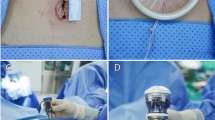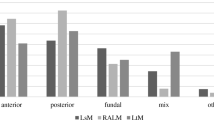Abstract
Minimizing the number of port incisions during minimally invasive surgery is associated with improved outcomes and patient satisfaction. We designed this work to study the perioperative outcomes of robotic single-site myomectomy (RSSM) in comparison to robotic multiport myomectomy (RMM) in a certain subset of patients. The design of the study is a multicenter retrospective analysis (Canadian Task Force classification III). The setting was three university hospitals. Eighty patients with symptomatic uterine fibroids undergoing robot-assisted single-site myomectomy were selected for the study. These 80 consecutive RSSM patients were matched at the uterine fibroid tumor burden level with 95 consecutive RMM patients performed at the same institutions, by the same surgeons, within a similar time frame. The main outcome measures were estimated blood loss (EBL), operative time, overnight admission, and post-operative complications. Of the 175 women, 95 (54.2%) underwent RMM and 80 (45.7%) underwent RSSM. Single-site vs. multiport patient demographics differed significantly in mean age (39.1 vs. 35.6, p < 0.001), and BMI (25.3 vs. 27.5, p < 0.04). Pre-operative MRI fibroid characteristics were matched between the two cohorts. Fibroid size on imaging (5.8 cm vs. 5.9 cm, p = 0.4) and the number of fibroids removed (2.5 vs. 2.3, p = 0.08) were similar between the two groups. After adjustment for multiple covariates with regression models, single-site myomectomy and multiport myomectomy has comparable EBL (83.3 mL vs. 109.2 mL, p = 0.34), operative time (162.4 min vs. 162.4 min, p = 0.99), overnight admission (OR = 1.54, p = 0.44) and a post-operative complication (OR = 1.3, p = 0.78). In selected patients, robotic single-site myomectomy is equivalent to its multiport counterpart. Both surgical approaches are associated with low rates of intra-operative and post-operative complications.
Similar content being viewed by others
Abbreviations
- RSSS:
-
Robot-assisted single-site myomectomy
- RMM:
-
Robot-assisted multiport myomectomy
- EBL:
-
Estimated blood loss
- MRI:
-
Magnetic resonance imaging
- BMI:
-
Body mass index
- SD:
-
Standard deviation
References
Okolo S (2008) Incidence, aetiology and epidemiology of uterine fibroids. Best Pract Res Clin Obstet Gynaecol 22(4):571–588
Merrill RM, Layman AB, Oderda G, Asche C (2008) Risk estimates of hysterectomy and selected conditions commonly treated with hysterectomy. Ann Epidemiol 18(3):253–260
Falcone T, Parker WH (2013) Surgical management of leiomyomas for fertility or uterine preservation. Obstet Gynecol 121(4):856–868
Barakat EE, Bedaiwy MA, Zimberg S, Nutter B, Nosseir M, Falcone T (2011) Robotic-assisted, laparoscopic, and abdominal myomectomy: a comparison of surgical outcomes. Obstet Gynecol 117(2 Pt 1):256–265
Holzer A, Jirecek ST, Illievich UM, Huber J, Wenzl RJ (2006) Laparoscopic versus open myomectomy: a double-blind study to evaluate postoperative pain. Anesth Analg 102(5):1480–1484
Jin C, Hu Y, Chen XC, Zheng FY, Lin F, Zhou K et al (2009) Laparoscopic versus open myomectomy–a meta-analysis of randomized controlled trials. Eur J Obstet Gynecol Reprod Biol 145(1):14–21
Buckley VA, Nesbitt-Hawes EM, Atkinson P, Won HR, Deans R, Burton A et al (2015) Laparoscopic myomectomy: clinical outcomes and comparative evidence. J Minim Invasive Gynecol 22(1):11–25
Pundir J, Pundir V, Walavalkar R, Omanwa K, Lancaster G, Kayani S (2013) Robotic-assisted laparoscopic vs abdominal and laparoscopic myomectomy: systematic review and meta-analysis. J Minim Invasive Gynecol 20(3):335–345
Choussein S, Srouji SS, Farland LV et al (2017) Robotic assistance confers ambidexterity to laparoscopic surgeons. J Minim Invasive Gynecol 25(1):76–83
Sinno AK. Fader AN (2014) Robotic-assisted surgery in gynecologic oncology. Fertil Steril 102:922–932
Canadian Medical Association Journal (2017). Retrieved September 07. From http://www.cmaj.ca/
Iavazzo C. Mamais I. Gkegkes ID (2016) Robotic assisted vs laparoscopic and/or open myomectomy: systematic review and meta-analysis of the clinical evidence. Arch Gynecol Obstet 294(1):5–17
Goebel K, Goldberg JM (2014) Women’s preference of cosmetic results after gynecologic surgery. J Minim Invasive Gynecol 21(1):64–67
Yeung PP Jr, Bolden CR, Westreich D, Sobolewski C (2013) Patient preferences of cosmesis for abdominal incisions in gynecologic surgery. J Minim Invasive Gynecol 20(1):79–84
Fanfani F, Monterossi G, Fagotti A, Scambia G (2014) Laparoendoscopic single-site hysterectomy: is it safe and feasible? Curr Opin Obstet Gynecol 26:275–280
Fagotti A, Boruta DM IInd, Scambia G, Fanfani F, Paglia A, Escobar PF (2012) First 100 early endometrial cancer cases treated with laparoendoscopic single-site surgery: a multicentric retrospective study. Am J Obstet Gynecol 206:353.e1–353.e6
Cela V, Freschi L, Simi G, Ruggiero M, Tana R, Pluchino N (2013) Robotic single-site hysterectomy: feasibility, learning curve and surgical outcome. Surg Endosc 27:2638–2643. 11
Bogliolo S, Ferrero S, Cassani C et al (2016) Single-site versus multiport robotic hysterectomy in benign gynecologic diseases: a retrospective evaluation of surgical outcomes and cost analysis. J Minim Invasive Gynecol 23:603–609
Yim GW, Jung YW, Paek J, Lee SH, Kwon HY, Nam EJ et al (2010) Transumbilical single-port access versus conventional total laparoscopic hysterectomy: surgical outcomes. Am J Obstet Gynecol 203(1):26 e1–e6
Kim TJ, Lee YY, Cha HH, Kim CJ, Choi CH, Lee JW et al (2010) Single-port-access laparoscopic-assisted vaginal hysterectomy versus conventional laparoscopic-assisted vaginal hysterectomy: a comparison of perioperative outcomes. Surg Endosc 24(9):2248–2252
Yoshiki N, Okawa T, Kubota T (2011) Single-incision laparoscopic myomectomy with intracorporeal suturing. Fertil Steril 95(7):2426–2428
Choi CH, Kim TH, Kim SH, Choi JK, Park JY, Yoon A et al (2014) Surgical outcomes of a new approach to laparoscopic myomectomy: single-port and modified suture technique. J Minim Invasive Gynecol 21(4):580–585
Eisenberg D, Vidovszky TJ, Lau J, Guiroy B, Rivas H (2013) Comparison of robotic and laparoendoscopic single-site surgery systems in a suturing and knot tying task. Surg Endosc 27(9):3182–3186
Angus AA, Sahi SL, McIntosh BB (2014) Learning curve and early clinical outcomes for a robotic surgery novice performing robotic single site cholecystectomy. Int J Med Robot 10(2):203–207
Truong M, Kim JH, Scheib S, Patzkowsky K (2016) Advantages of robotics in benign gynecologic surgery. Curr Opin Obstet Gynecol 28(4):304–310
Moawad GN, Samuel D, Abi khalil ED (2016) Tips and tricks: single-site robotic-assisted myomectomy. J Minim Invasive Gynecol 23(6):861
Gargiulo AR, Lewis EI, Kaser DJ, Srouji SS (2015) Robotic single-site myomectomy: a step-by-step tutorial. J Minim Invasive Gynecol 22(6S):S135
Munro MG, Critchley HO, Fraser IS (2011) The FIGO classification of causes of abnormal uterine bleeding in the reproductive years. Fertil Steril 95(7):2204-8, 2208.e1-3
Kroh M, El-Hayek K, Rosenblatt S, Chand B, Escobar P, Kaouk J et al (2011) First human surgery with a novel single-port robotic system: cholecystectomy using the da Vinci Single-Site platform. Surg Endosc 25(11):3566–3573
Gargiulo AR, Bailey AP, Srouji SS (2013) Robot-assisted single-incision laparoscopic myomectomy: initial report and technique. J Robot Surg 7(2):137–142
Lewis EI, Srouji SS, Gargiulo AR (2015) Robotic single-site myomectomy: initial report and technique. Fertil Steril 103(5):1370–1377 e1
Nam SH, Paek J, Choi C, Nam SH, Kim WY (2017) A comparison between reduced-port robotic surgery and multiport robot-assisted laparoscopy for myomectomy. Eur J Obstet Gynecol Reprod Biol 213:53–57
Sendag F, Akdemir A, Zeybek B, Ozdemir A, Gunusen I, Oztekin MK (2014) Single-site robotic total hysterectomy: standardization of technique and surgical outcomes. J Minim Invasive Gynecol 21(4):689–694
Scheib SA, Fader AN (2015) Gynecologic robotic laparoendoscopic single-site surgery: prospective analysis of feasibility, safety, and technique. Am J Obstet Gynecol 212(2):179 e1–e8
Gargiulo AR, Choussein S, Srouji SS, Cedo LE, Escobar PF (2017) Coaxial robot-assisted laparoendoscopic single-site myomectomy. J Robot Surg 11(1):27–35
Akdemir A, Zeybek B, Ozgurel B, Oztekin MK, Sendag F (2015) Learning curve analysis of intracorporeal cuff suturing during robotic single-site total hysterectomy. J Minim Invasive Gynecol 22(3):384–389
Gunderson CC, Knight J, Ybanez-Morano J, Ritter C, Escobar PF, Ibeanu O et al (2012) The risk of umbilical hernia and other complications with laparoendoscopic single-site surgery. J Minim Invasive Gynecol 19(1):40–45
FDA Safety Communication. Updated laparoscopic uterine power morcellation in hysterectomy and myomectomy. Available from https://www.fda.gov/medicaldevices/safety/alertsandnotices/ucm424443.htm
Funding
None.
Author information
Authors and Affiliations
Corresponding authors
Ethics declarations
Conflict of interest
Doctors Tyan, Paek, Tappy, Park, Chousein, Srouji, and Gargiulo declare that they have no conflict of interest. Dr. Moawad is a speaker for Intuitive Surgical.
Rights and permissions
About this article
Cite this article
Moawad, G.N., Tyan, P., Paek, J. et al. Comparison between single-site and multiport robot-assisted myomectomy. J Robotic Surg 13, 757–764 (2019). https://doi.org/10.1007/s11701-019-00919-0
Received:
Accepted:
Published:
Issue Date:
DOI: https://doi.org/10.1007/s11701-019-00919-0




